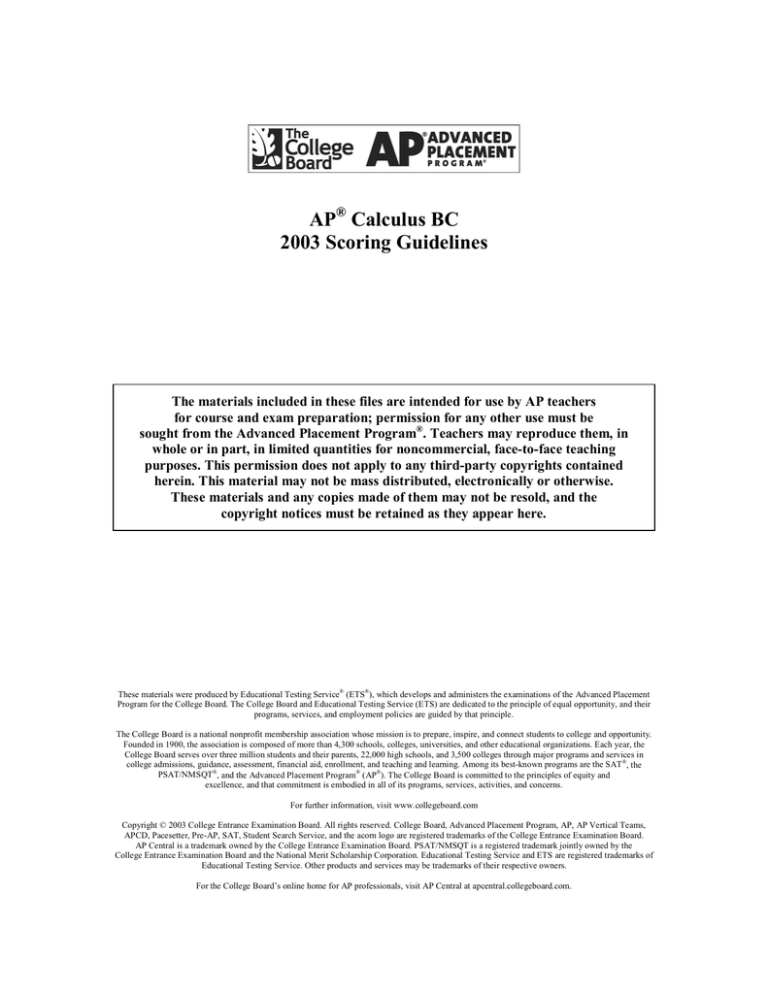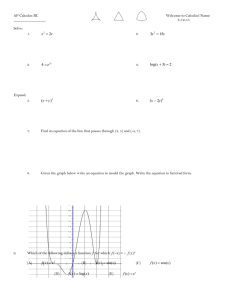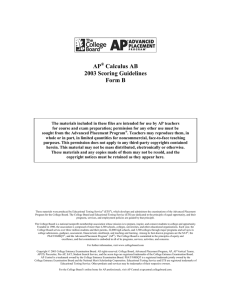2003 AP Calculus BC Scoring Guidelines - AP Central
advertisement

AP® Calculus BC 2003 Scoring Guidelines The materials included in these files are intended for use by AP teachers for course and exam preparation; permission for any other use must be sought from the Advanced Placement Program®. Teachers may reproduce them, in whole or in part, in limited quantities for noncommercial, face-to-face teaching purposes. This permission does not apply to any third-party copyrights contained herein. This material may not be mass distributed, electronically or otherwise. These materials and any copies made of them may not be resold, and the copyright notices must be retained as they appear here. These materials were produced by Educational Testing Service® (ETS®), which develops and administers the examinations of the Advanced Placement Program for the College Board. The College Board and Educational Testing Service (ETS) are dedicated to the principle of equal opportunity, and their programs, services, and employment policies are guided by that principle. The College Board is a national nonprofit membership association whose mission is to prepare, inspire, and connect students to college and opportunity. Founded in 1900, the association is composed of more than 4,300 schools, colleges, universities, and other educational organizations. Each year, the College Board serves over three million students and their parents, 22,000 high schools, and 3,500 colleges through major programs and services in college admissions, guidance, assessment, financial aid, enrollment, and teaching and learning. Among its best-known programs are the SAT ®, the PSAT/NMSQT®, and the Advanced Placement Program® (AP®). The College Board is committed to the principles of equity and excellence, and that commitment is embodied in all of its programs, services, activities, and concerns. For further information, visit www.collegeboard.com Copyright © 2003 College Entrance Examination Board. All rights reserved. College Board, Advanced Placement Program, AP, AP Vertical Teams, APCD, Pacesetter, Pre-AP, SAT, Student Search Service, and the acorn logo are registered trademarks of the College Entrance Examination Board. AP Central is a trademark owned by the College Entrance Examination Board. PSAT/NMSQT is a registered trademark jointly owned by the College Entrance Examination Board and the National Merit Scholarship Corporation. Educational Testing Service and ETS are registered trademarks of Educational Testing Service. Other products and services may be trademarks of their respective owners. For the College Board’s online home for AP professionals, visit AP Central at apcentral.collegeboard.com. AP® CALCULUS BC 2003 SCORING GUIDELINES Question 1 Let R be the shaded region bounded by the graphs of y = x and y = e 3x and the vertical line x = 1, as shown in the figure above. (a) Find the area of R. (b) Find the volume of the solid generated when R is revolved about the horizontal line y = 1. (c) The region R is the base of a solid. For this solid, each cross section perpendicular to the x-axis is a rectangle whose height is 5 times the length of its base in region R. Find the volume of this solid. Point of intersection e 3x = x 1: Correct limits in an integral in at (T, S) = (0.238734, 0.488604) (a) Area = 1 ¨T ( (a), (b), or (c) £¦ 1 : integrand 2 : ¦¤ ¦¦ 1 : answer ¥ x e 3x )dx = 0.442 or 0.443 2 1 e 3x ) ( 1 ( ( T (b) Volume = Q ¨ 1 x ) 2 )dx = 0.453 Q or 1.423 or 1.424 (c) Length = 1 ¨T 5 ( x e 3x ) 2 integrand < 1 > reversal < 1 > error with constant < 1 > omits 1 in one radius < 2 > other errors answer 2 : integrand £ ¦ ¦ ¦ ¦ < 1 > incorrect but has ¦ ¦ ¦ x e 3x 3 : ¦¤ ¦ ¦ ¦ as a factor ¦ ¦ ¦ ¦ 1 : answer ¦ ¥ x e 3x Height = 5 ( x e 3x ) Volume = £¦ 2 : ¦¦ ¦¦¦ ¦ ¦¦¦ 3: ¤ ¦¦¦ ¦¦ ¦¦ ¦¦ 1 : ¦¥ dx = 1.554 Copyright © 2003 by College Entrance Examination Board. All rights reserved. Available at apcentral.collegeboard.com. 2 AP® CALCULUS BC 2003 SCORING GUIDELINES Question 2 A particle starts at point A on the positive x-axis at time t = 0 and travels along the curve from A to B to C to D, as shown above. The coordinates of the particle’s position ( x ( t ), y ( t ) ) are differentiable functions of t, where x a( t ) = Qt ¬ Q t + 1 ¬ dx ­­ and y a( t ) = dy is not explicitly given. = 9cos ­­­ sin 6 ­® dt 2 dt ®­ At time t = 9, the particle reaches its final position at point D on the positive x-axis. dy dx positive? At point C, is positive? Give a reason for each answer. (a) At point C, is dt dt (b) The slope of the curve is undefined at point B. At what time t is the particle at point B ? 5 (c) The line tangent to the curve at the point ( x ( 8 ), y ( 8 ) ) has equation y = x 2. Find the 9 velocity vector and the speed of the particle at this point. (d) How far apart are points A and D, the initial and final positions, respectively, of the particle? dy is not positive because y(t ) is dt decreasing along the arc BD as t increases. dx At point C, is not positive because x (t ) is dt decreasing along the arc BD as t increases. (a) At point C, (b) ( ) Q t + 1 ­¬ dx Qt = 0 ; cos = 0 or sin ­­ = 0 2 dt 6 ® Qt Q Q t +1 or = Q ; t = 3 for both. = 2 6 2 Particle is at point B at t = 3. (c) x a(8) = 9 cos ( 43Q ) sin ( 32Q ) = 29 dx £ ¦ =0 1 : sets ¦ ¦ dt 2: ¤ ¦ ¦ 1:t =3 ¦ ¥ £ 1 : x a(8) ¦ ¦ ¦ ¦ 3 : ¤ 1 : y a(8) ¦ ¦ ¦ 1 : speed ¦ ¦ ¥ y a(8) dy 5 = = 9 x a(8) dx 5 5 y a(8) = x a(8) = 9 2 The velocity vector is < 4.5, 2.5 >. Speed = dy £ ¦ 1: not positive with reason ¦ ¦ dt 2 : ¦¤ ¦ dx ¦ 1: not positive with reason ¦ ¦ dt ¥ 4.52 + 2.52 = 5.147 or 5.148 (d) x (9) x (0) = 9 ¨0 x a(t )dt = 39.255 The initial and final positions are 39.255 apart. £¦ 1 : integral 2 : ¦¤ ¦¦ 1 : answer ¥ Copyright © 2003 by College Entrance Examination Board. All rights reserved. Available at apcentral.collegeboard.com. 3 AP® CALCULUS BC 2003 SCORING GUIDELINES Question 3 The figure above shows the graphs of the line x = x = 5 y and the curve C given by 3 1 + y 2 . Let S be the shaded region bounded by the two graphs and the x-axis. The line and the curve intersect at point P. (a) Find the coordinates of point P and the value of dx for curve C at point P. dy (b) Set up and evaluate an integral expression with respect to y that gives the area of S. (c) Curve C is a part of the curve x 2 y 2 = 1. Show that x 2 y 2 = 1 can be written as the polar 1 equation r 2 = . cos2 R sin2 R (d) Use the polar equation given in part (c) to set up an integral expression with respect to the polar angle R that represents the area of S. 5 3 y = 1 + y 2 , so y = . 4 3 5 5 Since x = y, x = . 3 4 £¦ 1 : coordinates of P ¦ 2 : ¦¤ ¦¦ 1 : dx at P ¦¥ dy (a) At P, dx = dy y = 1 + y2 3 3 3 dx y = 4= . . At P, 5 dy 5 x 4 ( ) £ ¦ 1 : limits ¦ ¦ ¦ 3 : ¤ 1 : integrand ¦ ¦ ¦ 1 : answer ¦ ¦ ¥ 5 1 + y 2 y dy 3 = 0.346 or 0.347 (b) Area = ¨0 4 £¦ 1 : substitutes x = r cos R and ¦¦ ¦ y = r sin R into x 2 y 2 = 1 2 : ¦¤ ¦¦ ¦¦ 1 : isolates r 2 ¦¥ (c) x = r cos R ; y = r sin R x 2 y 2 = 1 º r 2 cos2 R r 2 sin2 R = 1 1 r2 = 2 cos R sin2 R (d) Let C be the angle that segment OP makes with 3 y 3 the x-axis. Then tan C = = 4 = . 5 5 x 4 tan1 ( 3 5 ) 1 Area = ¨ r 2 dR 0 2 1 tan1 ( 3 5 ) 1 dR = ¨ 2 0 cos2 R sin2 R £¦ 1 : limits 2 : ¦¤ ¦¦ 1 : integrand and constant ¥ Copyright © 2003 by College Entrance Examination Board. All rights reserved. Available at apcentral.collegeboard.com. 4 AP® CALCULUS BC 2003 SCORING GUIDELINES Question 4 Let f be a function defined on the closed interval 3 b x b 4 with f ( 0 ) = 3. The graph of f a, the derivative of f, consists of one line segment and a semicircle, as shown above. (a) On what intervals, if any, is f increasing? Justify your answer. (b) Find the x-coordinate of each point of inflection of the graph of f on the open interval 3 < x < 4. Justify your answer. (c) Find an equation for the line tangent to the graph of f at the point ( 0, 3 ) . (d) Find f ( 3 ) and f ( 4 ) . Show the work that leads to your answers. (a) The function f is increasing on [3, 2] since f a > 0 for 3 b x < 2 . £¦ 1 : interval 2 : ¦¤ ¦¦ 1 : reason ¥ (b) x = 0 and x = 2 f a changes from decreasing to increasing at x = 0 and from increasing to decreasing at ¦£ 1 : x = 0 and x = 2 only 2 : ¦¤ ¦¦ 1 : justification ¥ x =2 (c) f a(0) = 2 1 : equation Tangent line is y = 2x + 3. (d) f (0) f (3) = 0 £¦ ¦¦ ¦¦ ¦¦ ¦¦ ¦¦ ¦¦ ¦¦ ¦¦ ¦¦ ¦¦ 4 : ¦¦¤¦ ¦¦ ¦¦ ¦¦ ¦¦ ¦¦ ¦¦ ¦¦ ¦¦ ¦¦ ¦¦ ¦¥¦ ¦ ¨3 f a(t )dt 1 1 3 = (1)(1) (2)(2) = 2 2 2 f (3) = f (0) + f (4) f (0) = 3 9 = 2 2 4 ¨0 ( f a(t )dt ) 1 = 8 (2)2 Q = 8 + 2Q 2 f (4) = f (0) 8 + 2Q = 5 + 2Q 1: ± ( 21 2 ) (difference of areas of triangles) 1 : answer for f (3) using FTC ( area of semicircle) 1 : answer for f (4) using FTC Copyright © 2003 by College Entrance Examination Board. All rights reserved. Available at apcentral.collegeboard.com. 5 ) 1 1 : ± 8 (2)2 Q 2 (area of rectangle AP® CALCULUS BC 2003 SCORING GUIDELINES Question 5 A coffeepot has the shape of a cylinder with radius 5 inches, as shown in the figure above. Let h be the depth of the coffee in the pot, measured in inches, where h is a function of time t, measured in seconds. The volume V of coffee in the pot is changing at the rate of 5Q h cubic inches per second. (The volume V of a cylinder with radius r and height h is V = Qr 2h. ) (a) Show that dh h = . dt 5 (b) Given that h = 17 at time t = 0, solve the differential equation dh h = for dt 5 h as a function of t. (c) At what time t is the coffeepot empty? dV £ ¦ 1: = 5Q h ¦ ¦ dt ¦ ¦ 3 : ¦¤ 1 : computes dV ¦ ¦ dt ¦ ¦ 1 : shows result ¦ ¦ ¥ (a) V = 25Qh dV dh = 25Q = 5Q h dt dt dh 5Q h h = = dt 25Q 5 (b) £¦ ¦¦ ¦¦ ¦¦ ¦¦ 5 : ¦¤ ¦¦ ¦¦ ¦¦ ¦¦ ¦¦ ¥ dh h = dt 5 1 1 dh = dt 5 h 1 2 h = t +C 5 2 17 = 0 + C ( h = 1 : separates variables 1 : antiderivatives 1 : constant of integration 1 : uses initial condition h = 17 when t = 0 1 : solves for h Note: max 2/5 [1-1-0-0-0] if no constant 1 t + 17 10 of integration ) 2 Note: 0/5 if no separation of variables (c) ( 1 t + 17 10 ) 2 =0 1 : answer t = 10 17 Copyright © 2003 by College Entrance Examination Board. All rights reserved. Available at apcentral.collegeboard.com. 6 AP® CALCULUS BC 2003 SCORING GUIDELINES Question 6 The function f is defined by the power series f (x ) = d ( 1 )n x 2n x2 x4 x6 ( 1 )n x 2n ( 2n + 1 ) ! = 1 3! + 5! 7 ! + " + ( 2n + 1) ! + " n =0 for all real numbers x. (a) Find f a( 0 ) and f aa( 0 ) . Determine whether f has a local maximum, a local minimum, or neither at x = 0. Give a reason for your answer. 1 1 approximates f ( 1 ) with error less than . (b) Show that 1 3! 100 (c) Show that y = f (x ) is a solution to the differential equation xy a + y = cos x . (a) f a(0) = coefficient of x term = 0 ( 31! ) = 13 f aa(0) = 2 (coefficient of x 2 term) = 2 f has a local maximum at x = 0 because f a(0) = 0 and f aa(0) < 0. (b) f (1) = 1 1 1 1 (1)n + +"+ +" 3! 5! 7! (2n + 1)! £ ¦ ¦ ¦ ¦ ¦ ¦ 4: ¤ ¦ ¦ ¦ ¦ ¦ ¦ ¦ ¥ 1 : f a(0) 1 : f aa(0) 1 : critical point answer 1 : reason 1 : error bound < 1 100 This is an alternating series whose terms decrease in absolute value with limit 0. Thus, the error is less than the 1 1 1 1 first omitted term, so f (1) 1 . b = < 3! 5 ! 120 100 ( (c) ya = ) 2x 4x 3 6x 5 (1)n 2nx 2n 1 + +"+ +" 3! 5! 7! (2n + 1)! (1)n 2nx 2n 2x 2 4x 4 6x 6 + +"+ +" 3! 5! 7! (2n + 1)! 2 1 2 4 1 4 6 1 6 xy a + y = 1 + x + + x + x +" 3! 3! 5! 5! 7! 7! 2n ¬ 2n 1 + (1)n + ­­­ x + " (2n + 1)! (2n + 1)! ® xy a = ( ) ( ) ( ) 1 1 1 (1)n 2n = 1 x2 + x4 x6 + " + x +" 2! 4! 6! (2n )! = cos x £¦ ¦¦ ¦¦ ¦¦ ¦¦ ¦¦ 4 : ¦¦¤ ¦¦ ¦¦ ¦¦ ¦¦ ¦¦ ¦¦ ¦¥¦ 1 : series for y a 1 : series for xy a 1 : series for xy a + y 1 : identifies series as cos x OR xy = xf (x ) = x OR x3 1 + " + (1)n x 2n +1 + " 3! (2n + 1)! = sin x xy a + y = ( xy )a = ( sin x )a = cos x £¦ ¦¦ ¦¦ 4 : ¦¤ ¦¦ ¦¦ ¦¦ ¦¥ 1 : series for xf (x ) 1 : identifies series as sin x 1 : handles xy a + y 1 : makes connection Copyright © 2003 by College Entrance Examination Board. All rights reserved. Available at apcentral.collegeboard.com. 7


